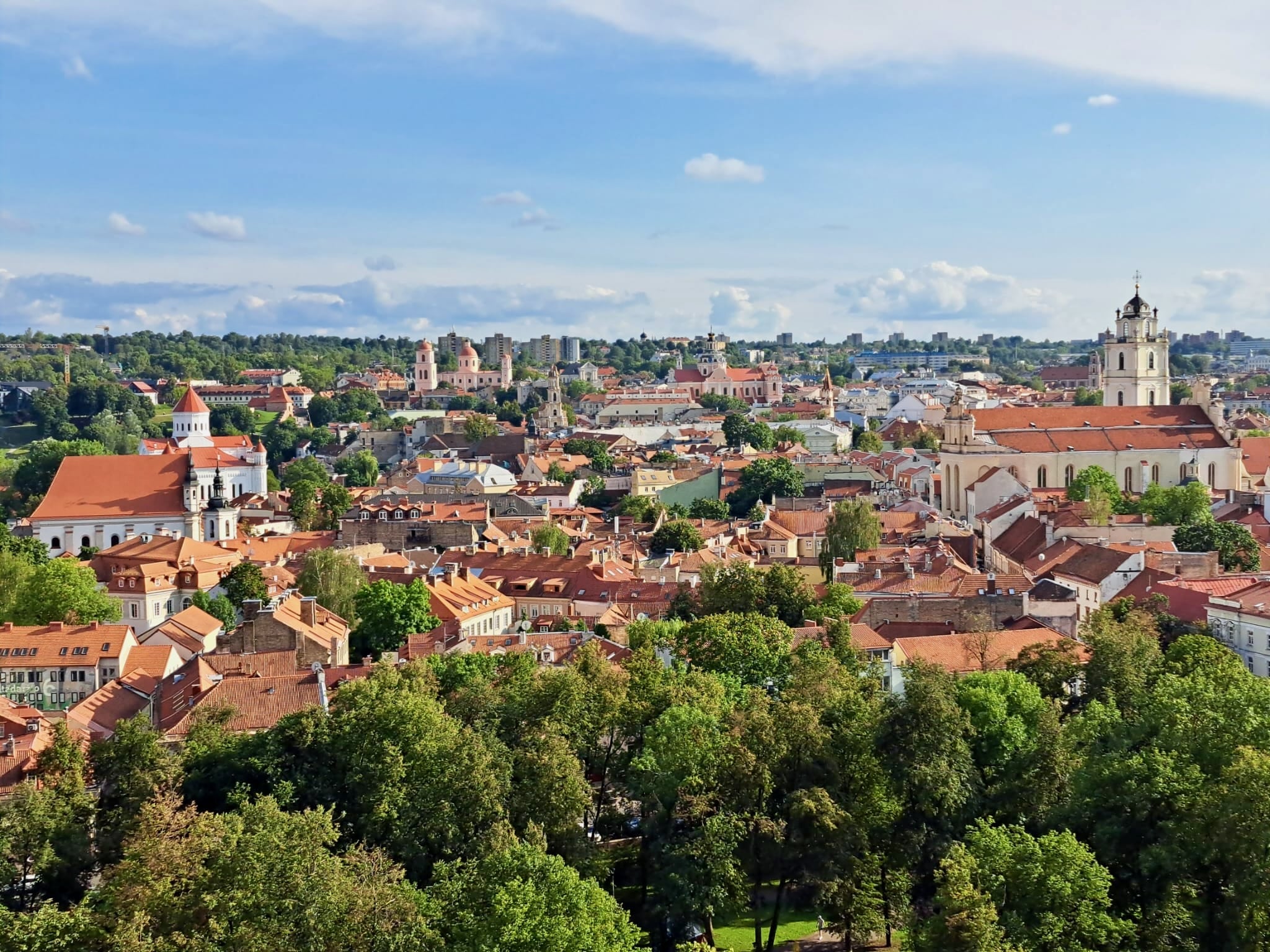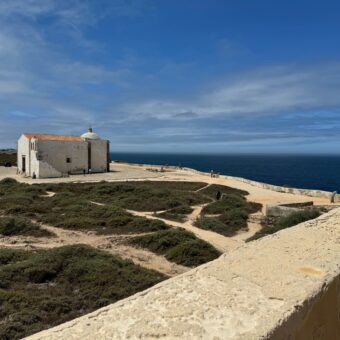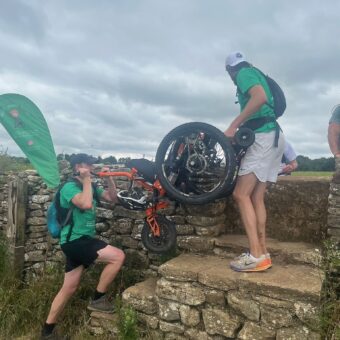Vilnius – exploring the green capital of Lithuania
Lithuania…. Maybe not the first place many people think of when planning a city break away. But a few days in the glorious capital of Vilnius convinced me that it absolutely should be on everyone’s wish list of places to visit.
Only two and a half hours from London, this beautiful Baltic city is all about ease. It was my first time flying from London City Airport, the capitals most central airport. I had a slight hiccup with parking, meaning I arrived at the airport with only an hour to go before my flight. But the check in process was very smooth. In fact, I made it through security with enough time to do a bit of shopping and grab some food before my flight. It was also my first time flying with LOT airlines. In all honesty, I had expected a standard budget airline experience. So, it was a pleasant surprise to be offered snacks and drinks to keep me going through the flight. And then after an easy and quick arrival process, it was only a fifteen-minute drive into the centre of the city.
Vilnius is one of Europe’s greenest capital cities. For both residents and visitors it offers a wonderful blend of city vibrancy and room to breathe. This was in evidence everywhere I went.
Where to begin?
I started my adventure on Pilies Street, the beating heart of the city. The name literally means Castle Street as it was originally the main route to the castle. It connects two of the capital’s main squares, Cathedral Square and Town Hall Square. It is mentioned as far back as 1530. But more than just a throughfare, nowadays it boasts diverse architecture and many landmarks, as well as a great array of eateries and independent shops.
The street is also home to Vilnius University with its observatory tower, founded in 1753 and the fourth oldest in Europe. On the wall is a plaque which references the university logo ‘Hinc itur ad astra’ which means ‘from here the way leads to the stars’. A rather lovely sentiment although ironically perhaps it should also say ‘Huc revertemur’ or ‘To here one will return’ as the tower makes a fantastic reference point being one of the highest buildings in the old part of the city – get lost and just look for it, it will bring you back!
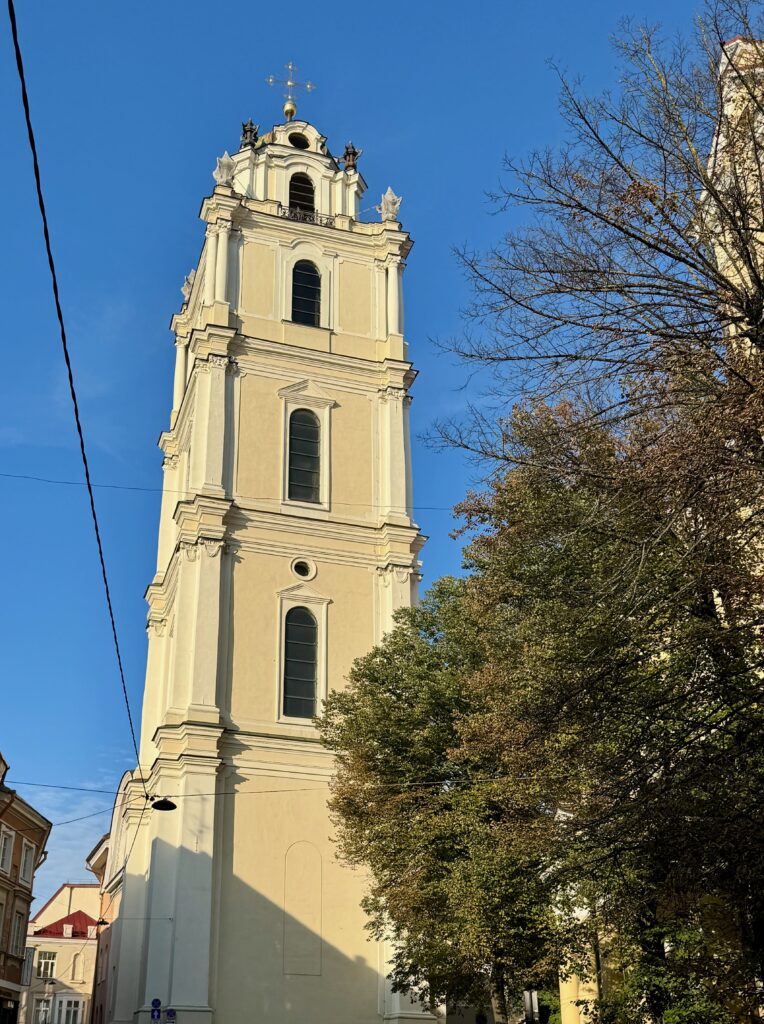
The historical centre of the city is a UNESCO World Heritage City. Covering 3.59 square kilometres, it is one of the largest surviving medieval old towns in Northern Europe. Yet despite its size it is easy to navigate around.
A short distance from Pilies Street brings you to the impressive Church of St Anne. Vilnius has a lot of churches, but this one is particularly standout. It is strikingly beautiful, built in the flamboyant Gothic style and with 33 different kinds of bricks used in its construction. Even Napoleon fell in love with it when he visited the city in 1812. In front of the church are benches that resemble enormous sweets. They offer a great place to just sit and take in the glorious building.
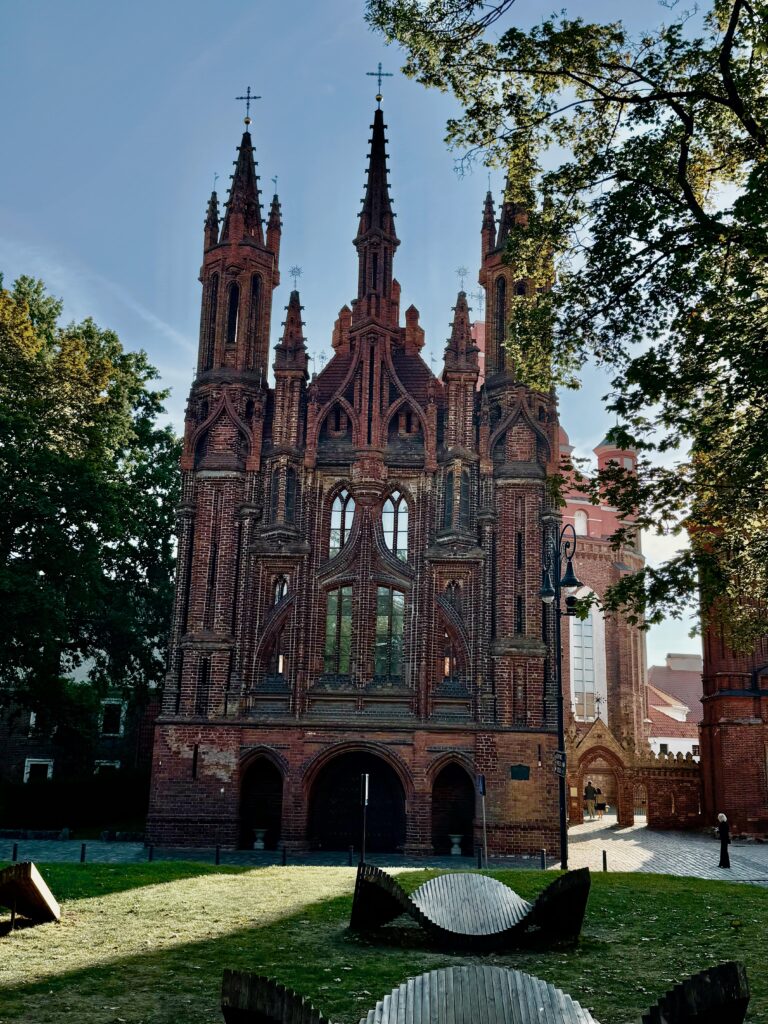
The Republic of Uzupis
A short amble from here and you arrive in the fabulous and quirky Uzupis. A self- proclaimed republic since 1997, it covers just one square kilometre. This makes it one of the smallest republics in the world. But its population of 7000 still have their own government and constitution, (created in three hours in the pub!) their own currency and even their own navy. Only three or four boats, but nonetheless!
The republic is home to the artistic. With a slightly Bohemian feel, there is a constantly changing display of artworks by the river. When I visited there was a stone washing machine, through the door of which I could view the river and beyond. It attracts people from many different nationalities.
Estimates state that there are people of 127 different ones living here. The aforementioned constitution, displayed on a wall in 44 different languages, reflects this. A wonderfully inclusive constitution, celebrating the right to be unique and to be from any nationality, it also recognises the absolute importance of the fact that ‘A dog has the right to be a dog’! Perhaps all have been enticed to stay by Uzupis’ famous mermaid. Her charms are said to encourage all who visit to not want to leave… I am someone who gets a little too excited about stamps in my passport. So I was delighted to be able to add another as I entered the republic. However, it is the first time I have ever had my passport stamped over the bar in a pub!

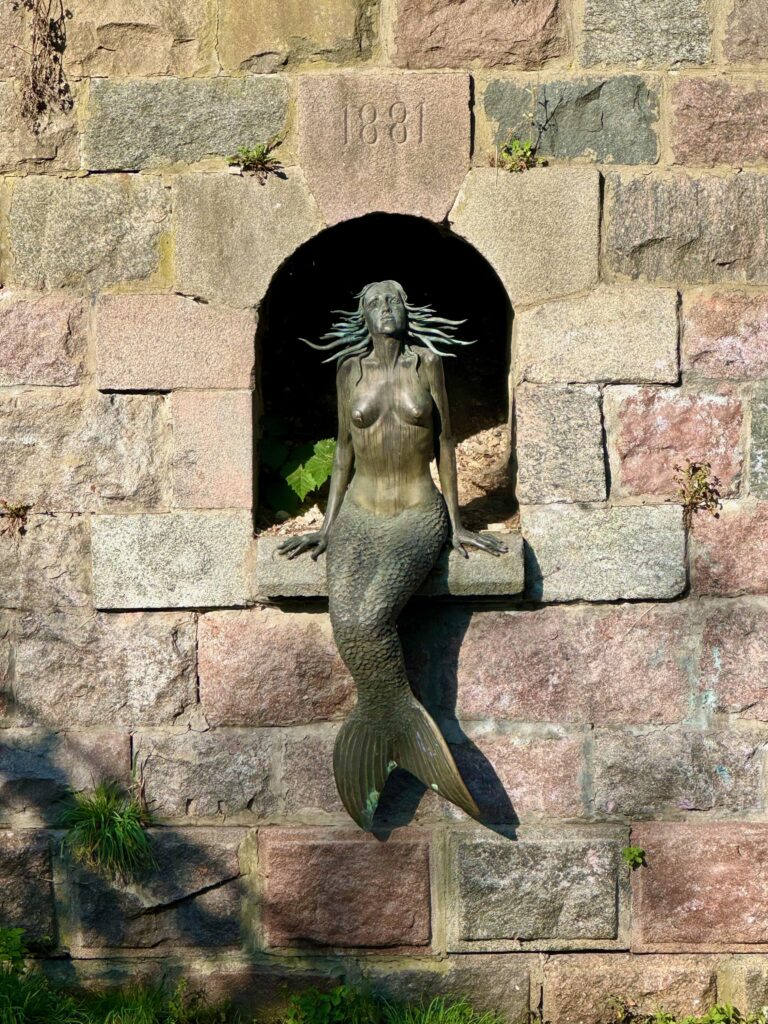
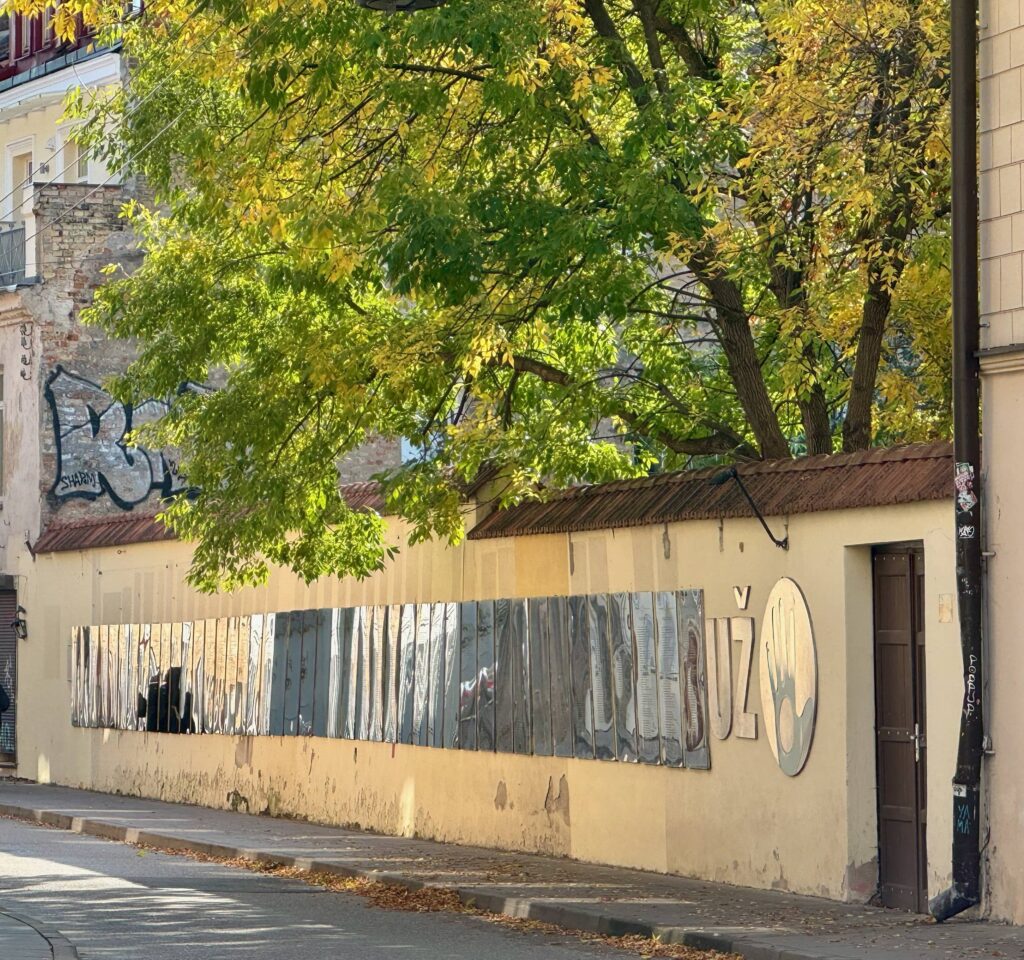
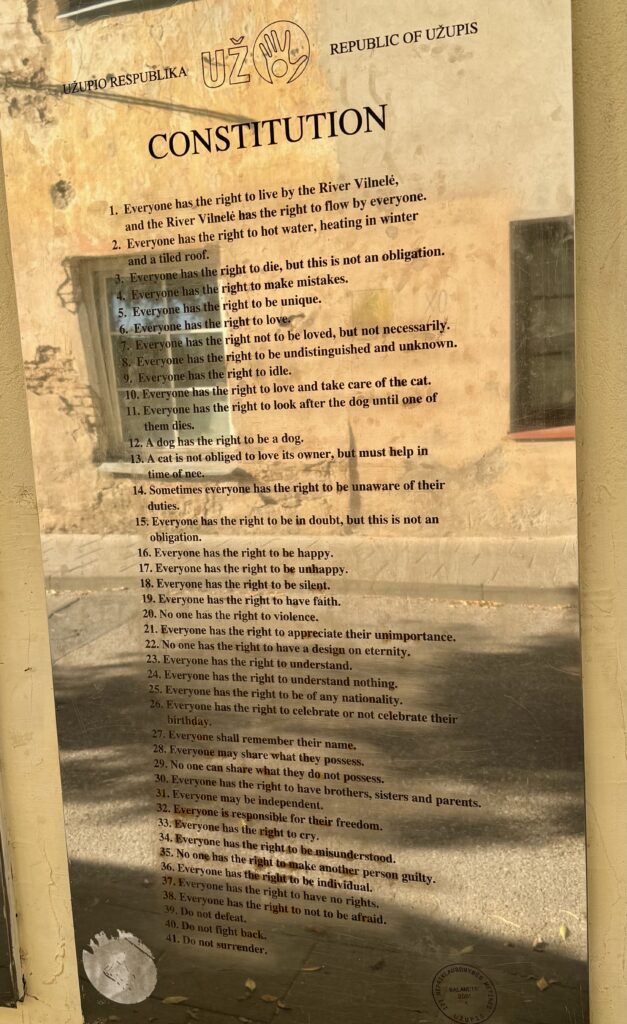
The heart of Vilnius Old Town
Access to the 14th century centre of Vilnius’ Old Town is through the Gate of Dawn, the start of the Royal Road. The Chapel in the gate houses an important icon of the Virgin Mary. Reputed to have miraculous powers, it is an important pilgrimage site for Lithuanians. Many miracles are associated with the icon. However, she does sport some war wounds, still bearing the hole from the bullet fired at her by occupying Swedish forces. Legend has it that it was here the heavy iron gate fell one Sunday morning, crushing four of those same Swedish soldiers who were cursing the Lithuanians praying to Mary.

The Jewish ghetto
The site of the first Lithuanian parliament and a unique cheese shop leads one down to the site of the former Jewish ghetto. While little traces remain of its former inhabitants, it is a sobering reminder of the devastation wreaked on Lithuania’s Jews by the Nazis. Estimates of those killed suggest around but range from 190,00 people, more than 95% of its Jewish population. A huge number of these perished between June and December 1991 when the Germans invaded the USSR. It was a more complete elimination than suffered by any other country,. Even now, Jews even now only make up 0.4% of Lithuania’s population.
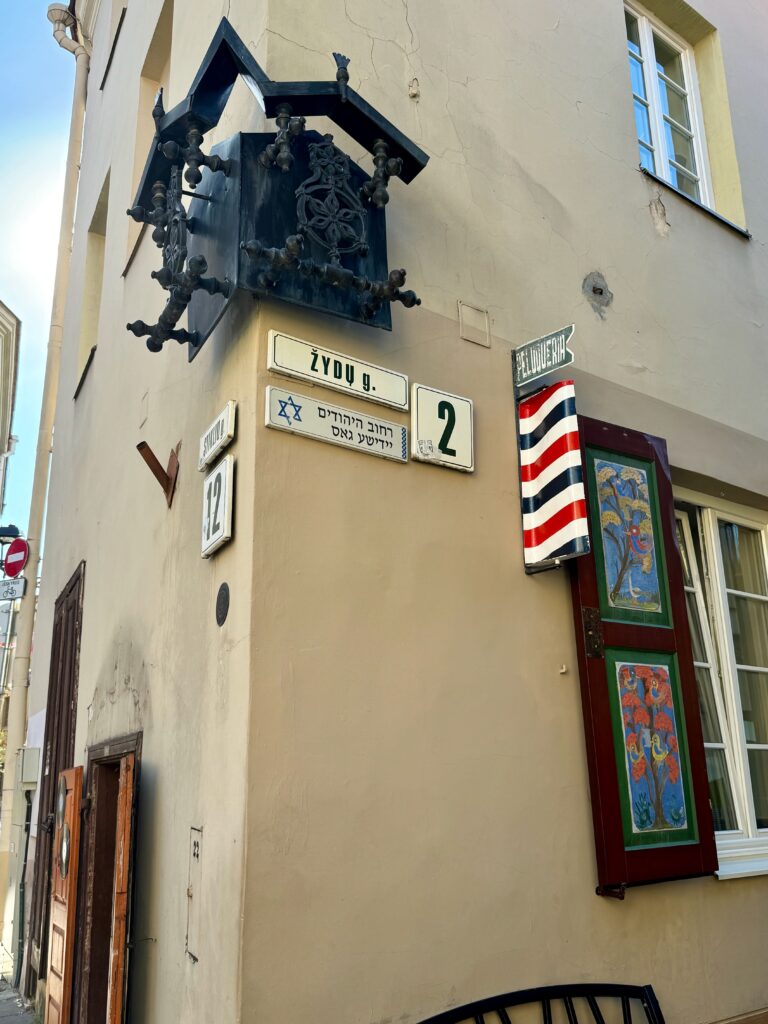
This is not the only mark of Lithuania’s turbulent past. Only declaring its independence in 1991, Lithuania’s chequered history has seen it under rule of many others, most recently the Soviets from 1940-1991.
The Museum of Occupations and Freedom Fights
Nowhere are the repressions this enforced displayed more clearly than at the Museum of Occupations and Freedom Fights. Former headquarters to the KGB in Lithuania, this innocuous looking building bears testament to many of the atrocities inflicted on the people by the occupiers. There is a strange atmosphere on entering. The hairs stood up on my arms and despite the numbers of other visitors it felt eerily quiet.
58 cells in the basement witnessed much suffering, including tortures and executions. There were both criminal and political prisoners. The KGB arrested one out of three priests. Many ended up here even though religion was not officially a crime in Soviet times. Informers also met a brutal end – one cell had a button where, after suffering more than they could endure, prisoners were enticed to press a button to offer their statement and so they thought, ensure their release. However, they were then taken to the regular cells, where the other prisoners’ hatred of informers led them to kill their own. Encouraged to turn upon one another at every point, no one was safe in Soviet Lithuania.
The personal connection
Our guide was incredible – having worked there since 1992 when it reopened as a museum, he fully submersed himself in the role, making us question everything while adding many personal reflections on the impact of Soviet occupation. He explained how the impacts of that time were felt by every Lithuanian even today. He also underlined the ‘back of the mind’ concern for everyone that it could all be revisited. His comment on many of the young ‘Smoking, drinking, never thinking’ stuck fast in my mind, reminding me of the need for everyone not to forget what has happened before.
The most sobering part for me was the ceiling in one of the cells. It was covered with letters written by many of the prisoners when they were herded into animal trucks to be taken to the concentration camps. Written to loved ones with no knowledge of if they would ever reach them, these letters had been found hidden between the bars of the carriages in the hope that somehow the sentiments in them would find their way to the people who mattered.
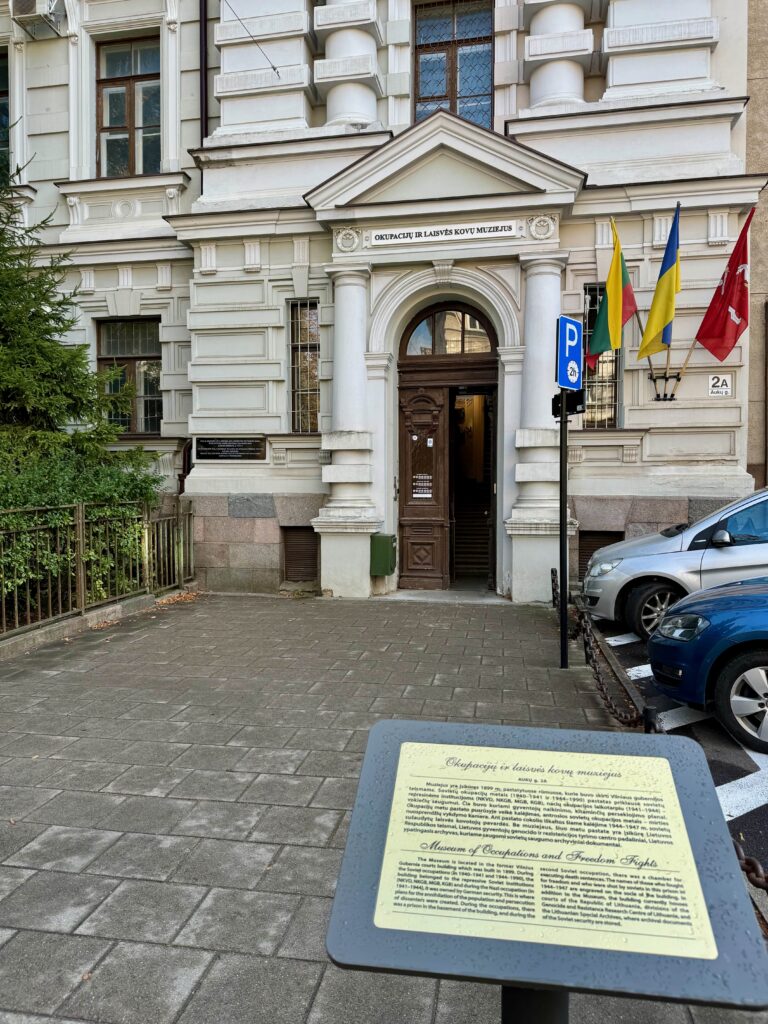
Lukiskes Prison
A good half-way house between horror and hope was the Lukiskes prison. Built in 1901, it served as a prison until 2019. Originally built to house 800 prisoners, during the Russian occupation its numbers exceeded 8,700. During this time, prisoners often lived in terrible conditions. Some experienced isolation in dark rooms with no light for 23 hours a day. Their only respite was an hour’s exercise in outdoor, windowless cells. Nowadays the prison is reinventing itself as an art and music venue. Local artists can rent a cell for their studio. Bands play on the large stay erected in the prison courtyard. Weekly outdoor film nights fill the courtyard with laughter and fun, a far cry from its original existence.


Vilnius and its inhabitants, along with the rest of the country have undoubtedly suffered over the years. But while the whispers are there, this is a city that is reinventing itself. It has made great strides towards becoming a modern, inviting place to be. Talk to anyone – they are proud to live there. As a city, it offers opportunity and a good standard of living. Locals can commute to work easily with everywhere being in easy reach. They can make the most of the green spaces that are in abundance in the city or take a short trip out to soak up even more.
Trakai
One such place is Trakai. Just 17 miles from Vilnius, this small peninsular town lies on a beautiful lake which boasts the fairy-tale Trakai castle. The original home of Lithuania’s Grand Dukes a boat trip offers a wonderful vantage point to enjoy it. The town itself is peaceful, but the lake is a popular destination for locals and tourists alike. There is the opportunity to try out varying water sports or just relax and enjoy the nature. The highlight for me was learning about the local people and trying the local delicacy, kybyn. Not unlike a Cornish pasty, which always goes down well with the local me, these small, pastry wrapped parcels have been made by the Karaim people for decades and are now part of the Lithuanian culinary heritage.


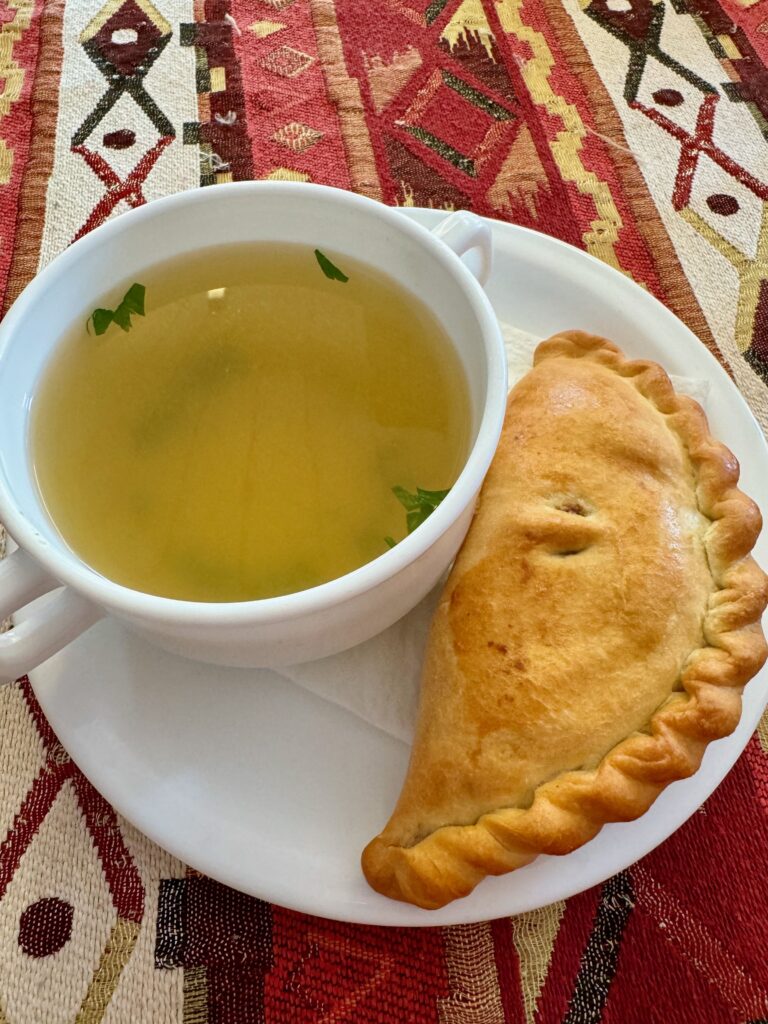
From hate to love
Perhaps fitting in the city’s move towards a more positive future is the story of love that is proudly told. The tale of Barbora Radvilailte and Zygmintas Augustus, shares many parallels with that of Romeo and Juliet. But this real-life love story happened forty years before the story of the star-crossed lovers was even conceived. A tour follows all the key points that punctuate their story including the secret passage, that Zygmintas, Grand Duke of Lithuania and later King of Poland, built to visit his love in secret. It really was rather wonderful and described a story well known to every local.
Vilnius today
To really get a sense of the city itself there are a couple of options – one is to visit the Vilnius TV tower – at 362m tall it is higher than both Big Ben and the Pyramids of Giza. For the brave it is possible to do an edge walk. Tethered by just a small rope, you can walk around the external platform, hundreds of metres above the city. It is an incredible view if somewhat terrifying! Time it right though – I visited in the golden hour and the city looked truly magical when lit up by the glow of the sinking sun.

Another alternative is the Gendiminas tower – the last remaining tower of the original castle a small and full accessible funicular takes you up to the top from where you have a panoramic view of the whole city.

It is also worth visiting Literati Street. Only a few hundred metres from Uzupis, this quaint little street is adorned with plaques and artworks all of which represent the creatives of Lithuania – from writers and poets, to artists and sculptors it reinforces what the city is all about. With a history of kings and grand dukes, academics and artists, the city was never for trade. Instead it was a place for science, education and culture, and still is to this day.

Gastronomy
it is also worth noting the thriving food scene in the capital. As proud home to four Michelin starred restaurants it definitely has a lot to offer for the foodie traveller. Whatever you want, you can find it here. Maybe that is traditional Lithuanian fare, substantial and nourishing, being rich in sour cream and paprika. Or maybe you are looking for a more refined take on tradition, such as that created by the chef at Nineteen18, you will not go hungry.
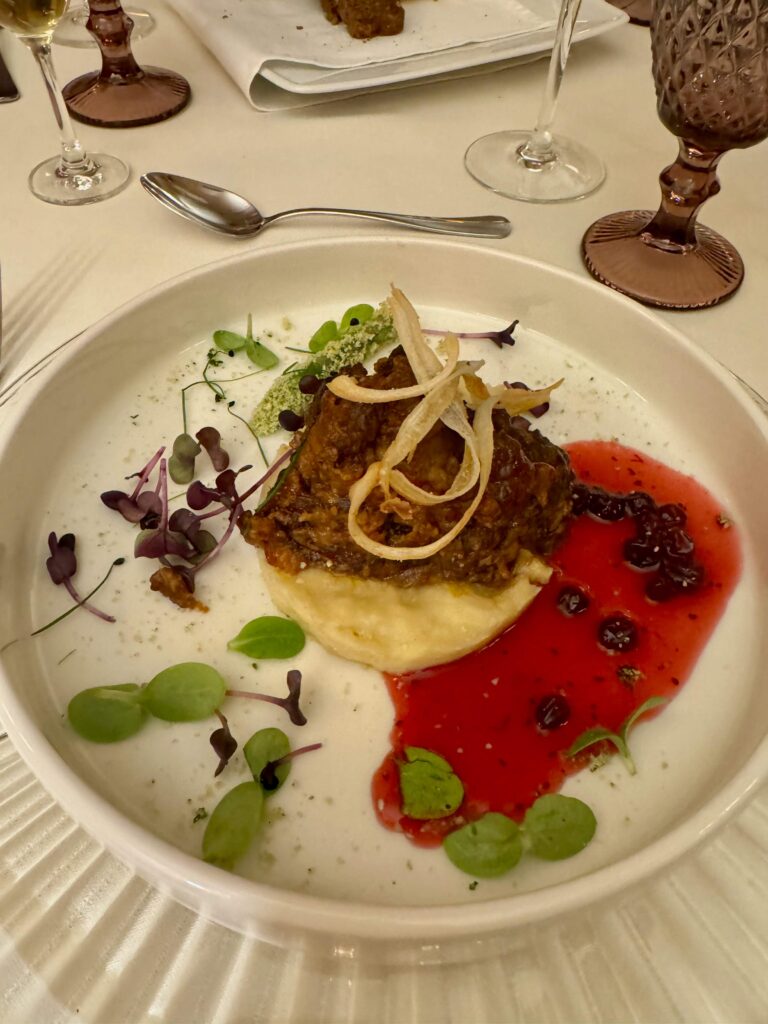
I absolutely loved Vilnius – there is so much history and I have only scratched the surface. I loved the spirit of the place and the people. Although I was only there for a few days I heard many stories which testified to their determination and resilience. That may have been women hiding books under their skirts so that they could teach the children and keep their language alive. Or the stories of the Baltic Way when two million people joined hands, starting in Vilnius, to protest against Soviet occupation. These stories show what can happen when ordinary people come together.

Where I stayed
My home for the few days was the Hotel Narutis, Vilnius’ oldest hotel. Originally built in medieval times, it was originally an inn before operating non-stop as a hotel since 1918. The hotel has added a floor every century since it was built and is now an impressive sight on entry. A balconied reception area, adorned with lots of greenery and atmospheric lighting invites you in.
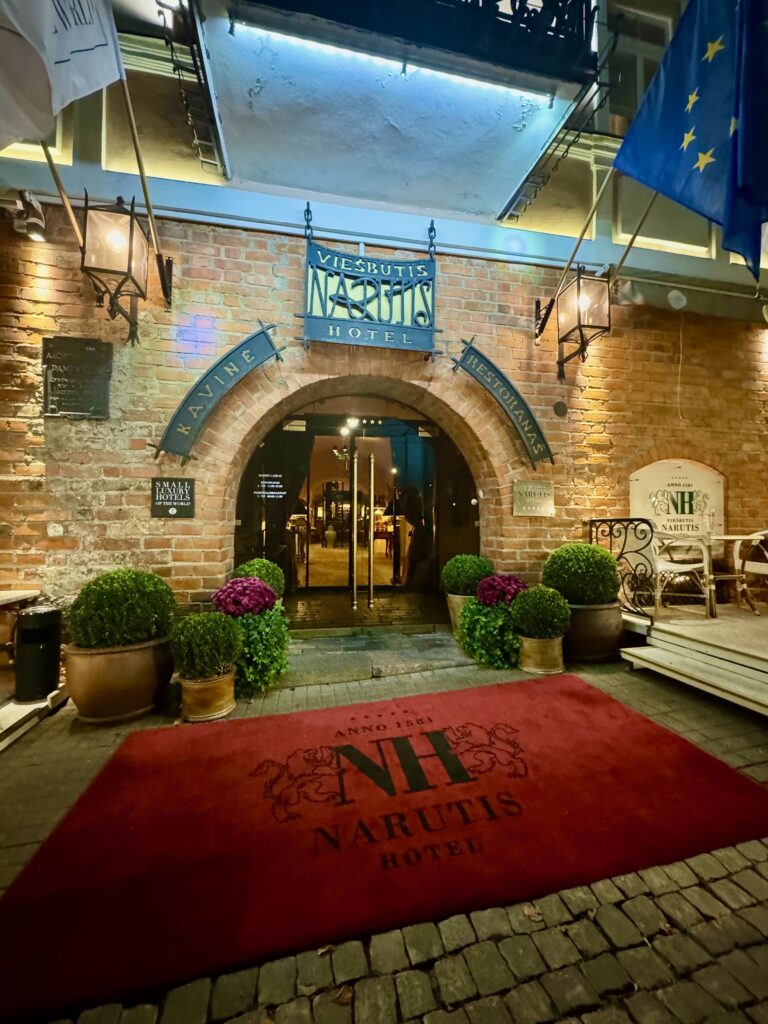
Accessibility in Vilnius
But what of accessibility? Surprisingly good, all in all. The city itself is easy to navigate, compact and straightforward to get around. It is easy to get to most places under your own steam, however, should you wish to use public transport many of the buses and trams offer step free access. Pavements are generally wide and flat, with several drop kerbs. There are some cobbles, but these are mostly well maintained and not too bone shaking!
There are a number of modern hotels in the city which offer accessible rooms. One even has ten which is practically unheard of! Access to shops and restaurants is varied. There are many which offer straightforward access although a set of portable ramps could come in very useful.
Unfortunately, the Museum of Occupation and Freedom Fights is not accessible, the entrance being up a set of steep stairs. Lukiskes prison is also limited – while the courtyard offers no obstacles the cells inside are up stairs. There is talk of creating a 3D virtual tour so that less mobile visitors can experience the prison more fully, although this is still a work in progress.
Despite this, Vilnius still has plenty to offer the disabled traveller and definitely deserves a place on any ‘To visit ‘list!
Further information
For more information please visit:
Museum of Occupation and Freedom Fights https://www.genocid.lt/muziejus/en/
Lukiskes Prison https://www.lukiskiukalejimas.lt/pasivaiksciojimai/en/home-eng/
Vilnius TV Tower https://tvbokstas.lt/en/
Gendiminas Tower https://lnm.lt/en/museums/gediminas-castle-tower/
Hotel Narutis https://narutis.com

